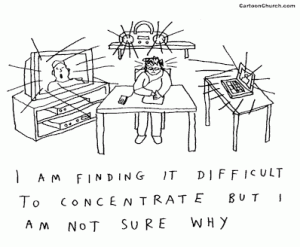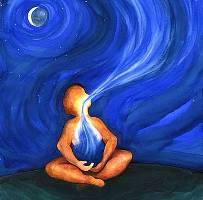 Dharana is a Sanskrit word which means immovable concentration of the mind (or that which gives stability”) from the root Dhar, which means to “bind together”, “to make stable”. Dharanais the willful act of concentration of the mind.
Dharana is a Sanskrit word which means immovable concentration of the mind (or that which gives stability”) from the root Dhar, which means to “bind together”, “to make stable”. Dharanais the willful act of concentration of the mind.
Dharana is the sixth of Patanjali’s “Eight Limbs” of Raja Yoga (or classical yoga). Patanjali describes Dharana thusly: “When the pure mind is kept focused in the desired desa (region) by the seeker, it is called Dharana.”
Patanjali considered Dharana, Dhyana and Samadhi to be the last three steps in his eightfold path and that all three aspects considered together are collectively termed “Samyama” (Control). We should also keep in mind, that Dharana, Dhyana and Samadhi are progressively advancing stages of concentration. The highest stage of mental concentration described by the Western psychologists is similar to the description of Dharana which Patanjali designated as the initial or primary stage of concentration, with Dhyana as the intermediate and Samadhi as the final or highest stage.
Characteristically there is no dividing line in between any of these three stages. When certain progress is made in the practice of Dharana, Dhyana stage is automatically entered into and so on with the progress through Dharana stage, the student or yogi automatically enters in the Samadhi stage. The three stages are said to mingle into each other as easily as three colors are mixed together on an artists palate.
In this article we will consider only the first stage; Dharana, (Dhyana and Samadhi to be considered in upcoming articles).

In practicing Dharana, the student creates a condition conducive for the mind to focus its attention in one direction or on one object rather than of radiating out in a multitude of different directions. As concentration deepens, the focus on a single chosen point becomes more intense and the other preoccupations of the mind cease to exist.
The objective in Dharana is to steady the mind by focusing its attention efficiently on one subject or point of experience. Concentrate on any object (within the body or outside) that is appealing, selecting any object that’s pleasant and brings in concentration of the mind easily. Now if the student chooses to focus on their inner energy flow, they can directly experience the physical and mental blocks and imbalances that remain in their system, in other words, the obstacles to their progress becomes obvious.
Once established, this ability to withdraw the mind from all its “fluctuations” (or modifications), and concentrate on a single point produces psychological health and personal integration and should not be considered an escape from reality, but instead, a positive movement towards the realization of the true nature of the Self. This prepares the student for the next stage (Dhyana), where concentration becomes meditation and the one meditating becomes one with the object of meditation.
In summary: The practice of Pratyahara creates the setting for Dharana or concentration. When one is relieved of outside distractions, they can now deal with the distractions of the mind itself. In the practice of concentration, which precedes meditation, a student can learn how to slow down the thinking process by concentrating on a single mental object. The goal is to become aware of nothing except the object of concentration, it can be a candle flame, a flower, a mantra you repeat to yourself, a specific energetic center in the body, a picture of a guru or an image of a deity, any of the chakras can also be used as a focal point for concentration. The ultimate purpose of Dharana is to train the mind over time by eliminating all the extra, unnecessary superfluous thought. Extended periods of concentration will naturally lead to meditation (Dhyana).

Related article, click on: The Eight Limbs of Yoga (Part 5 – Pratyahara)
Check back soon for “The Eight Limbs of Yoga (Part 7 –Dhyana)”

 By controlling the act of breathing the student can efficiently and effectively control the various motions in the body and the different nerve currents that are animating the body. When practiced properly, one can easily and quickly gain control over body and mind through Pranayama, developing character and consciously harmonizing the individual’s life with the cosmic or Divine life.
By controlling the act of breathing the student can efficiently and effectively control the various motions in the body and the different nerve currents that are animating the body. When practiced properly, one can easily and quickly gain control over body and mind through Pranayama, developing character and consciously harmonizing the individual’s life with the cosmic or Divine life.